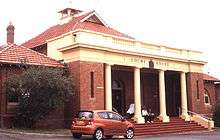George McRae
| George McRae | |
|---|---|
 George McRae, circa 1890 | |
| Born |
10 September 1858 Edinburgh, Scotland |
| Died |
16 June 1923 (aged 64) Sydney, New South Wales, Australia |
| Nationality | Scottish Australian |
| Occupation | Architect |
| Spouse(s) | Katie Prescott |
| Practice | NSW Government Architect |
| Buildings |
|
George McRae (10 September 1858 – 16 June 1923) was a Scottish architect who migrated to Australia and pursued his career in Sydney, where he became Government Architect of New South Wales and designed some of Sydney's best-known buildings, including completion of the Sydney Town Hall,[1] the Queen Victoria Building, and the lower entrance to Taronga Zoo.
Life
George McRae was born in Edinburgh in 1858. The register of his birth records his father as Duncan (joiner journeyman) and his mother as Mary. He arrived in Sydney in 1884 and was appointed Assistant Architect in the City Architect’s office. He became City Architect and City Building Surveyor in 1889. He held this position until 1897, when he was appointed Principal Assistant Architect to Walter Liberty Vernon in the Government Architect's Branch.[2] In 1912 he succeeded Vernon as New South Wales Government Architect and held the position until he died in 1923.[3]
McRae married Katie Prescott in St Mark's, Darling Point on 8 May 1895.[4]
Career
George McRae was responsible for the design of many buildings in Sydney and other places, several of which still survive and are heritage-listed. Works undertaken by McRae during his term as Government Architect included the Education Dept Building 1912; Parcels Post Office 1913; Taronga Zoo lower entrance, top entrance, and Indian elephant house; additions to the Colonial Treasury Building in Bridge Street, and Cessnock Court House. Some of the extant buildings are:
- Rozelle Tram Depot, located in Glebe, New South Wales, 1904; Federation Queen Anne style, saw-tooth, corrugated iron roof concealed by a brick stepped parapet structure.
- Education Department Building, Bridge Street, Sydney, 1912; a six-storey sandstone building with steel and reinforced concrete structure and a central light-well, listed on the Register of the National Estate.[5]:94
- Former Parcels Post Office, Railway Square, Sydney, 1913; a brick and sandstone building in the Federation Free Classical style, described as "an ingeniously designed and monumental building."[6] This distinctive building used to house a post office, Telecom Telex machine centre and a tool store; it has now been fully restored and reopened as an "executive hotel".
- Taronga Zoo lower entrance, top entrance and Indian elephant house, Mosman, Sydney, 1916; replaced first zoo at Moore Park, has a Local Government Heritage listing.[7]
- Corporation Building, Hay Street, Sydney, circa 1893; known at first as the Municipal Building, this building combined Queen Anne and Anglo-Dutch influences, and originally had a ground-floor market stall arcade. It is listed on the Register of the National Estate[5]:102
- Additions to the Colonial Treasury Building, Bridge Street, Sydney, originally built circa 1849, extensions circa 1896; listed on the Register of the National Estate[5]:105
- Queen Victoria Building, George Street, Sydney, 1893–98; a sandstone masterpiece in American Romanesque style, reopened in 1986 as a retail centre after major restoration, and listed on the Register of the National Estate[5]:100
- Former Sydney City Markets, Ultimo Road, Haymarket, 1910. Part of the market complex that included the vegetable market, Hay Street, and the markets bell tower, Quay Street. Later converted to a hotel.
- Corn Exchange, Sussex Street, Sydney; built by City Council in 1887 and attributed to McRae. A two-storey building with an unusual curved facade, listed on the Register of the National Estate.[5]:110
- Court House, Maitland Street, Cessnock, New South Wales; the State Government set aside land in 1905 that established Cessnock as the administrative centre of the coal fields in that part of the Hunter Valley. This included the court house, which now has a Local Government Heritage listing.[7]
- St James railway station, Sydney.
Funeral
McRae's funeral was held on 18 June 1923 at Rookwood Cemetery and was attended by a large number of people from the Public Works Department and other government departments.[8] He was survived by his wife, son and two daughters.
Gallery
 Cessnock Court House
Cessnock Court House.jpg) Queen Victoria Building with Sydney's former tram service in view, circa 1920
Queen Victoria Building with Sydney's former tram service in view, circa 1920- Education Department, Bridge Street, Sydney
- Former City Markets building, Ultimo Street
- Former Parcel Post Office, Railway Square, Sydney
- Corn Exchange, Sussex Street, Sydney
References
| Wikimedia Commons has media related to George McRae. |
- ↑ "Sydney Town Hall (Place ID 1904)". Australian Heritage Database. Department of the Environment. 21 March 1978. Retrieved 23 September 2016.
- ↑ Gadsdon, J.B. (1983). "Queen Victoria Building - The Splendour of a Civic Market". Historic Australia. March/April (3): 37.
- ↑ Sydney Architecture: Retrieved 17 August 2009
- ↑ Register of Births Deaths and Marriages, New South Wales. Registration #4084/1895
- 1 2 3 4 5 The Heritage of Australia. 2. Macmillan Company. 1981.
- ↑ Apperly, Richard (1994). A Pictorial Guide to Identifying Australian Architecture. Angus and Robertson. p. 106.
- 1 2 "NSW Heritage Site". Retrieved 18 August 2009.
- ↑ "Obituary". The Sydney Morning Herald (NSW: 1842 - 1954). NSW. 19 June 1923. p. 10. Retrieved 27 March 2014.